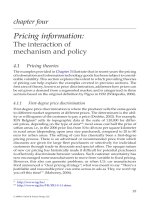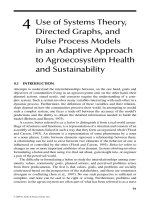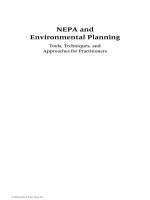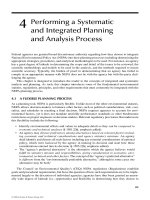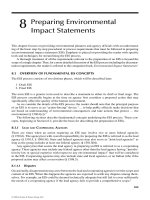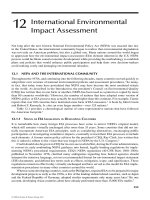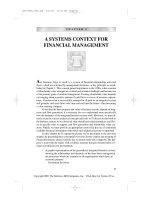Poverty Impact Analysis: Approaches and Methods - Chapter 4 ppt
Bạn đang xem bản rút gọn của tài liệu. Xem và tải ngay bản đầy đủ của tài liệu tại đây (117.57 KB, 10 trang )
CHAPTER 4
Poverty Predictor Modeling in the
People’s Republic of China: A Validation
Survey
Pingping Wang
Introduction
Based on poverty predictors identifi ed in Sangui, Pingping, and Heng (2005)
and listed in Appendix 3.1, a short questionnaire was developed and used in
a pilot survey to determine whether or not the poor in a particular location
could be identifi ed without conducting an income and expenditure survey. If
the tool could be used to identify the poor, it would be useful for evaluating
the impact of a poverty reduction project on a target area. To be able to
validate the results of the survey, the questionnaire included questions on
the respondents’ income and expenditures. A comparison was also carried
out on the accuracy of the assessment of households’ poverty status based on
results of different assessors.
Data and Methods
Sample Size and Data Gathering
The pilot survey
1
was conducted in fi ve counties in the province of Yunnan
in the People’s Republic of China (PRC). The coverage area was along the
Asian Development Bank–fi nanced Kunming-Dali expressway. A total of
1,000 households spread over 50 villages were interviewed. In each county,
there were 10 villages and 200 households selected. In each village, 20
households were selected, of which 10 households were from the sample
coverage of the China Rural Poverty Monitoring Survey (CRPMS), while the
rest were newly selected samples. A total of 45 villages with 450 households
were taken from the CRPMS while 5 villages and 550 households were non-
CRPMS.
Field supervisors had made several trips to check and ensure that the
enumerators followed the guidelines of the survey manual, directly assess the
1
The questionnaire used in the pilot survey can be downloaded at .
org/Statistics/reta_6073.asp.
Application of Tools to Identify the Poor
118 Poverty Predictor Modeling in the People’s Republic of China: A Validation Survey
poverty status of the households according to the poverty predictors, observe
the reaction of respondents to the survey questions, and discuss the survey
with government staff of counties and townships, village heads, villagers,
owners and employees of enterprises, farmers, etc.
The pilot survey also identifi ed the poverty status of households based
on judgments of village heads, neighbors, enumerators, and the households
themselves.
Income and living expenditure data were collected through daily recording
and were regarded as actual data in this study. The result was compared
with the perception of household poverty status based on the independent
assessments.
Validation Method
As a preliminary step, the signifi cance of the predictors of household poverty
status was fi rst validated using the results from the pilot survey data and the
existing national poverty monitoring survey, that is, the CRPMS. The coeffi cients
of poverty predictors of the ordinary least squares (OLS) model for the subsample
group Data1 in Sangui, Pingping, and Heng (2005) were applied to 450 sample
households from the CRPMS to predict the per capita living expenditure for the
said sample. The result was regarded as predicted data in this study.
Next, the levels of predicted and actual per capita expenditure were compared
with poverty lines CNY700,
2
CNY1,000, and CNY1,500 to determine the measures
of poverty status. CNY700 was an approximation of the offi cial rural poverty line,
which was CNY668 in 2004. CNY1,000 was an approximation of the current
offi cial poverty line for the low-income group, which was CNY924 in 2004 and
was about $1-a-day at purchasing power parity prices. Finally, CNY1,500 was
an approximation of the proposed poverty line for the rural upper-income group.
Also, data were divided into low-, middle-, and high-income groups based on per
capita expenditure and predicted and actual data were compared. Cross tabulation
of actual and predicted poverty measures as well as income groups would reveal
the accuracy of the poverty predictors.
The next task was to build the new OLS regression and logit models using
the results of the pilot survey and the signifi cant predictor variables previously
mentioned. For OLS regression, predicted per capita consumption derived
from the survey was then compared to the three poverty lines mentioned
above to again determine the measures of poverty status. Actual and predicted
measures were again cross tabulated to reveal accuracy. For the logit model,
2
CNY stands for Chinese Yuan.
Poverty Impact Analysis: Tools and Applications
Chapter 4 119
sensitivity and specifi city coeffi cients were directly computed to determine
the accuracy of the prediction.
In eliminating the bias of self-reporting, the respondent’s welfare status
was also evaluated by three other individuals: village head, the respondent’s
neighbor, and the survey enumerator. The respondent was rated by evaluators
according to the following categories: poor, low-income, and nonpoor.
For the fi nal step of validation, means of measures of poverty predictors
for poor and nonpoor were subjected to a test of mean difference using a
t-test.
Results
Poverty-Predictor Accuracy Based on 450 CRPMS Households
Applying the coeffi cients of poverty predictors of the OLS model to 450
sample households from the CRPMS would reveal that expected value of per
capita consumption is quite close to the actual daily reporting of individual
consumption with minimum variance (Table 4.1).
As shown in Table 4.2, as the poverty line increases, the accuracy of
predicting the poor household increases, while the reverse is observed in
predicting the nonpoor. It might be noted that everyone with per capita
consumption above CNY700, is predicted as nonpoor, which implies that
there could be serious prediction problems if the poverty line used is too low.
This is in line with the fi nding of this book’s Chapter 3.
Table 4.1 Statistical Summaries of Per Capita Expenditure
Variable Number Mean (CNY) Standard Error
Actual
450 1664.57 1180.49
Predicted
450 1673.26 615.26
Source: Authors’ calculation based from 2002 CRPMS.
Table 4.2 Poverty Status Using the CNY700, CNY1000, and
CNY1500 Poverty Lines—Actual Versus Predicted
Predicted
700 CNY 1000 CNY 1500 CNY
Nonpoor Nonpoor Poor Nonpoor Poor
Actual
Nonpoor
100.0 98.5 1.5 73.2 26.8
Poor
100.0 88.1 11.9 44.7 55.3
Source: Authors’ calculation based on 2002 CRPMS.
Application of Tools to Identify the Poor
120 Poverty Predictor Modeling in the People’s Republic of China: A Validation Survey
To further validate the model, the households’ per capita expenditure was
divided into low, middle, and high groups.
3
The empirical result shows that
poverty among the low-income group can be predict ed at 61 percent, while
the high-income group can only be predicted at 59 percent. The middle
group seems to have low prediction capability (Table 4.3).
Poverty Predictor Accuracy of Households in the Pilot Survey
From the OLS estimation, the model generated predicted per capita
expenditures, which were then compared with the three poverty lines.
As shown in Table 4.4, increasing poverty lines increase the likelihood of
accurately predicting the poor but the reverse is observed in predicting the
nonpoor.
Logistic regression was also used to predict whether a household was poor
or not. Here, poverty was measured using CNY1,500 per capita expenditure
as the poverty line. The dependent variable was whether the household was
poor (with per capital expenditure below CNY1,500), where 1 is poor and 0
is nonpoor.
Accordingly, as shown in Table 4.5, the percentage of poor correctly
predicted was about 82 percent and the percentage of nonpoor correctly
predicted was around 76 percent. This indicates that logistic regression is
more powerful than OLS regression in terms of predicting poverty. The
3
All households were divided equally based on predicted per capita consumption as well
as actual per capita consumption.
Table 4.3 Comparing Households Based on Per Capita
Expenditure—Actual Versus Predicted
Predicted
Low Middle High Total
Actual
Low
61.30 28.70 10.00 100.00
Middle
22.70 46.00 31.30 100.00
High
16.00 25.30 58.70 100.00
Total
100.00 100.00 100.00 -
Source: Authors’ calculation based on 2002 CRPMS.
Table 4.4 Classifying Poor and Nonpoor Using the Per Capita
Expenditure—Actual Versus Predicted
Predicted Based on Per Capita Living Expenditure
700 CNY 1000 CNY 1500 CNY
Nonpoor Poor Nonpoor Poor Nonpoor Poor
Actual
Nonpoor
98.8 1.20 91.0 9.0 72.1 27.9
Poor
68.8 31.30 59.0 41.0 23.5 76.5
Source: Authors’ calculation based on 2002 CRPMS.
Poverty Impact Analysis: Tools and Applications
Chapter 4 121
probability of incorrectly predicting the poor (poor that were actually not
poor), is 24 percent while the probability of the opposite case is 18 percent.
An Alternative Approach for Identifying the Poor
Using the evaluators’ judgment of the respondents’ poverty status, results reveal
that while the respondents themselves perceive that most of them belong to
low-income or poor groups, the evaluators perceive the respondents to be in
low-income or nonpoor groups (Table 4.6). Thus, there was an upward bias
in estimating the number of poor based on respondents’ own perceptions.
Using the 1,000 household responses, the local perception of poverty was
matched with the identifi ed poverty predictors. A respondent was categorized
as poor if and only if all evaluators rated the respondent as such. If the
respondent rated himself or herself as poor and the rest of the evaluators
did not, the respondent was classifi ed as nonpoor. This method classifi ed
138 households as poor category, while 119 households were classifi ed as
nonpoor. The predictors were considered to be reliable if they were present
in poor households but not in nonpoor households.
Table 4.7 shows the mean values of the poverty predictor variables from
the survey results. The last column shows the t-Statistics of the differences
Table 4.5 Accuracy of Predicted Poverty Status Using the
Logit Model with CNY1,500 Poverty Line
(percent)
Sensitivity
82.04
Specificity
76.14
Positive predictive value
80.09
Negative predictive value
78.36
False positive rate for true nonpoor
23.86
False negative rate for true poor
17.96
False positive rate for classified poor
19.91
False negative rate for classified nonpoor
21.64
Correctly classified
79.32
Probability cut off of 0.20
Source: Authors’ calculation based on 2002 CRPMS.
Table 4.6 Classification of Poor and Nonpoor Based on Different Assessors
(percent)
Assessors Poor Low-Income Nonpoor Total
Village head
7.50 20.60 71.90 100.00
Enumerator
5.50 19.40 75.10 100.00
Neighbor
7.50 20.70 71.80 100.00
Respondent: based on income
10.70 76.70 12.60 100.00
Respondent: based on expenditure
19.40 74.20 6.40 100.00
Source: Authors’ calculation based on 2002 CRPMS.
Application of Tools to Identify the Poor
122 Poverty Predictor Modeling in the People’s Republic of China: A Validation Survey
in the means of the nonpoor and poor. A predictor was eliminated if the
difference was not signifi cantly different from 0 at a 95 percent confi dence
level, that is, when both poor and nonpoor households were locally perceived
to have the same characteristics.
For further refi nement, those that did not provide substantial information
on the differences between poor and nonpoor were also eliminated. For
instance, the average number of residents per household for the nonpoor
was 4.56 and for the poor it was 4.22. Although their t-statistic for mean
difference was high enough, the predictor does not notably distinguish
between the two groups.
Table 4.7 also shows that some identifi ed poverty predictors that have
positive coeffi cients from the linear regression model developed in Sangui,
Pingping, and Heng (2005)—indicating that the higher value of the predictor
increases the log of per capita expenditure of a household—turned out to
be more apparent among poor households than in nonpoor ones. Family
structure, where the household has other members apart from immediate
family, is an example of such a poverty indicator. The coeffi cient for the
linear regression was positive when only 5 percent among the nonpoor
households have other members, whereas it was 14 percent among the poor
households.
The new sets of predictors provide indicators of the household’s
poverty status. Of the 1,000 households, 15 percent have at least one of the
demographic characteristics, 84 percent possess at least one of the assets
common to poor households, 99 percent have heads that were either single
or have a high school education or less (up to none at all), and 21 percent live
in mountainous areas. There were only 42 households that met all of the four
criteria above and almost half of them were identifi ed to be poor by at least
one of the evaluators.
Table 4.8 presents the percentage distribution of households classifi ed as
poor according to the group of predictors. Notable is the high percentage
(83 percent) of the population that were categorized as poor because they have
at least one of the assets common to poor households and have household
heads that are either single or have low education levels. There was a small
percentage of the population who were classifi ed as poor because of their
household demographics and because they live in mountainous areas.
Poverty Impact Analysis: Tools and Applications
Chapter 4 123
Table 4.7 Mean of Poverty Predictors and T-Statistics of the Mean Difference
Household Characteristics
PPM
Coefficient
+/-
Mean
t-Statistics
Nonpoor Poor
Household Demographics
Number of residents 4.56 4.22 2.10
Aged 0–14 years + 1.49 1.40 0.94
Aged 15–60 years + 3.31 2.86 3.21
Aged over 60 years old + 1.26 1.32 -0.57
Staying at home for 6 months or more - 4.19 4.12 0.39
Number of school-age children in school + 1.48 1.42 0.59
Family structure:
Has parents and no children + 0.03 0.00 1.45
Has parents and one child + 0.13 0.13 0.09
Has parents and two children ++ 0.27 0.29 -0.34
Has parents and three children or more ++ 0.03 0.00 1.45
Has either one of the parents and children ++ 0.00 0.06 -2.50
Has three generations ++ 0.45 0.34 1.72
Has other members ++ 0.05 0.14 -2.32
Has disabled adults at home ns 0.02 0.19 -4.62
Ratio of labor to household members - 0.67 0.61 2.32
Activities and Access to Services
Celebrates big events ++ 0.21 0.27 -1.05
Engaged in large-scale production + 0.05 0.02 1.21
A household member is the village leader + 0.28 0.03 5.60
Number of members that work outside the village + 1.53 1.26 1.88
Ratio of cash crop areas to total sown areas + 0.26 0.23 0.92
Has grain that is enough for consumption + 0.99 0.94 2.28
Uses coal or gas for cooking + 0.65 0.28 6.25
Has no income sources (Wu Bao Hu) - 0.00 0.00 -
Participates in cooperative medical service - 0.06 0.00 2.48
Has insurance + 0.37 0.11 5.00
Asset Ownership
Has big animals - 0.69 0.65 0.65
Has pigs + 0.68 0.90 -4.53
Has sheep or goat - 0.04 0.18 -3.68
Has a radio + 0.44 0.25 3.25
Has a refrigerator + 0.19 0.02 4.46
Has a TV + 0.99 0.67 7.76
Has a bicycle + 0.72 0.29 7.49
Has a motorcycle + 0.28 0.07 4.52
Has a telephone + 0.63 0.18 8.12
Has a car or truck + 0.11 0.00 3.61
Has a hand tractor + 0.06 0.02 1.40
Has other agricultural tools + 0.26 0.29 -0.65
Has draught animal + 0.38 0.59 -3.38
Has production animal + 0.40 0.24 2.69
Has toilet + 0.91 0.68 4.96
Has electricity ns 1.00 0.97 2.02
Amount of grain stored at home at the end of the year (kg/person) + 332.40 295.24 1.45
(continued on next page)
Application of Tools to Identify the Poor
124 Poverty Predictor Modeling in the People’s Republic of China: A Validation Survey
Household Characteristics
PPM
Coefficient
+/-
Mean
t-Statistics
Nonpoor Poor
Amount of grain stored for consumption at home at the end of the year
(kg/person)
ns 220.18 165.02 3.05
Floor area of house per household member (square meters) + 36.37 31.52 2.12
Area of house allotted for production (square meters) + 51.37 46.60 0.76
Area of barn for livestock (square meters) ns 34.06 29.10 1.76
Has difficult access to drinking water - 0.11 0.34 -4.44
Finds collecting fuels getting more difficult - 0.47 0.61 -2.34
Natural Resources
Area of cultivated land per capita + 1.16 1.05 1.50
Area of forest land per capita + 1.61 2.36 -0.91
Area of orchard land per capita ns 0.40 0.40 -0.02
Area of grassland areas per capita + 0.15 0.10 1.29
Wasteland areas per capita ns 1.06 0.77 0.42
Household Head Characteristics
Sex of the household head is male 0.92 0.93 -0.32
Age of the household head - 44.77 42.57 1.70
Marital status:
Single - 0.01 0.10 -2.98
Married + 0.96 0.83 3.70
Divorce 0.01 0.06 -2.00
Household head can speak Chinese + 0.99 0.99 -0.10
Educational attainment:
Without formal education + 0.01 0.12 -3.49
With primary school education + 0.33 0.54 -3.40
With middle school education + 0.52 0.29 3.85
With high school education + 0.10 0.20 2.30
With college education or higher ++ 0.01 0.00 0.68
Village Characteristics
Village physiognomy:
Has plate land + 0.60 0.47 2.04
Has hilly areas + 0.32 0.06 5.45
Has mountainous areas ns 0.06 0.45 -8.04
Number of natural villages with a road for motor vehicles + 10.47 15.97 -5.43
Distance to the town where the township government is located (km) + 2.13 2.74 -4.52
Distance to the nearby market (kilometers) + 2.44 2.80 -2.59
Natural disaster occurs in the village - 0.85 0.52 5.85
Village designated as poor by the National Poverty Reduction Project - 0.37 0.15 4.01
ns = not (statistically) significant
Source: Authors’ calculation based on the household survey used by Sangui, Pingping, and Heng.
Table 4.7 continued
Table 4.8 Distribution of Households Identified as Poor
(Percent)
Identified Poor by:
Household
Demographics
Asset
Ownership
Household
Head Characteristics
Village
Characteristics
Household Demographics
14.7 11.7 14.7 4.4
Asset Ownership
11.7 83.5 83.0 20.5
Household Head Characteristics
14.7 83.0 99.3 20.9
Village Characteristics
4.4 20.5 20.9 21.1
Source: Authors’ calculation based on the household survey with N=1,000 households as generated by Sangui, Pingping, and Heng.
Poverty Impact Analysis: Tools and Applications
Chapter 4 125
Conclusion
Although every country’s poverty situation is unique, the underlying
determinants of poverty generally point to a household having low income
or facing limited access to income sources. The poverty predictors generated
in this study suggest that households are poor because they either have low
income or diffi cult access to income sources. The fi rst can be attributed to
having fewer income earners, which was evident form the poor households’
characteristics. The second can be attributed to the households’ inability to
generate higher income because of low education levels that limit them from
engaging in other gainful economic activities, or the households’ geographic
location that prevents them from having access to wider markets for their
products and services.
In addition, some predictors, such as those under asset ownership, were
outcomes rather than determinants of income status. For instance, a household
with a radio, refrigerator, TV, bicycle, motorcycle, telephone, among other
assets, was generally classifi ed as nonpoor. Poor households, on the other
hand, generally have sheep or goats, or have diffi culty accessing drinking
water and fuel. The capability of households to purchase relatively more
expensive assets signify higher income compared with those who cannot
afford them. On the other hand, the inability of households to acquire easier
access to drinking water, for instance, signifi es lower income compared with
those who can afford household appliances.
The poverty predictors thus covered indicators of both causes and effects
of poverty. Because the predictors were initially derived by correlating
the household’s per capita consumption expenditure and the household’s
characteristics, they refl ect the relevance of purchasing power as a factor in
defi ning poverty. In addition, because they were also derived using local
perceptions of poverty, the predictors likewise refl ect the multidimensional
aspects of poverty that include not only the level of income but also other
factors that make a household socially and economically disadvantaged.
The households classifi ed as poor by community characteristics, for
instance, were poor because they were located in mountainous areas and
were not able to generate as much farm income as those households located
on fl atter land. The cost of living in mountainous regions is usually higher
and, hence, some of the households classifi ed as nonpoor by a common
poverty line may in fact be poor in this region. The predictors, therefore, go
beyond the numeric defi nition of poverty set by poverty lines.
In terms of the accuracy of the poverty predictor model, the empirical
study suggests that the logistic regression model is more accurate than the
Application of Tools to Identify the Poor
126 Poverty Predictor Modeling in the People’s Republic of China: A Validation Survey
multiple regression technique. With the given set of predictors or variables
to characterize the poor and nonpoor, a survey is an effective instrument
to monitor and evaluate the impact of poverty-related projects in the PRC.
However, for the purpose of evaluating the effectiveness of the project,
the identifi ed poverty predictor variables should be incorporated in the
instrument before the start of any poverty reduction project or program.

